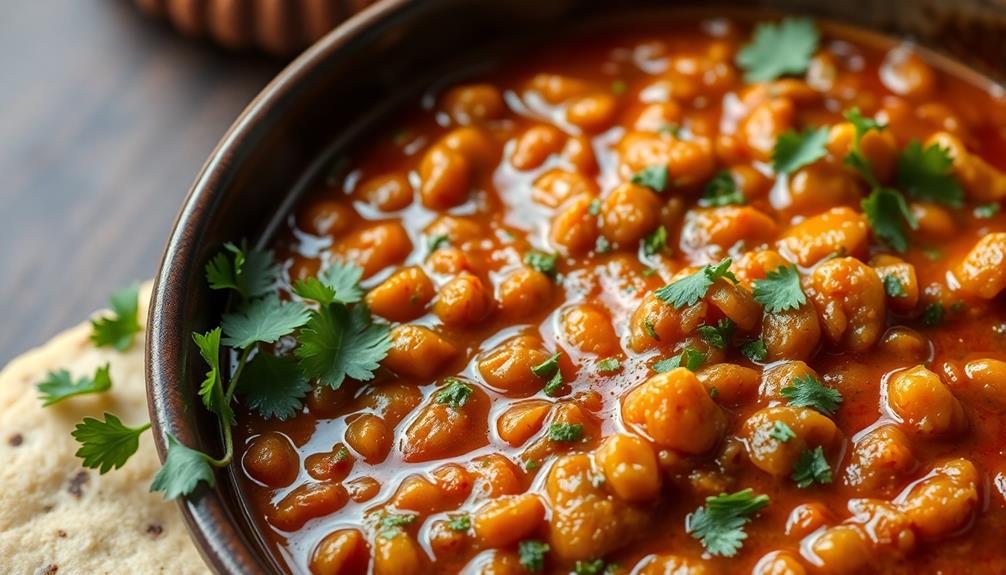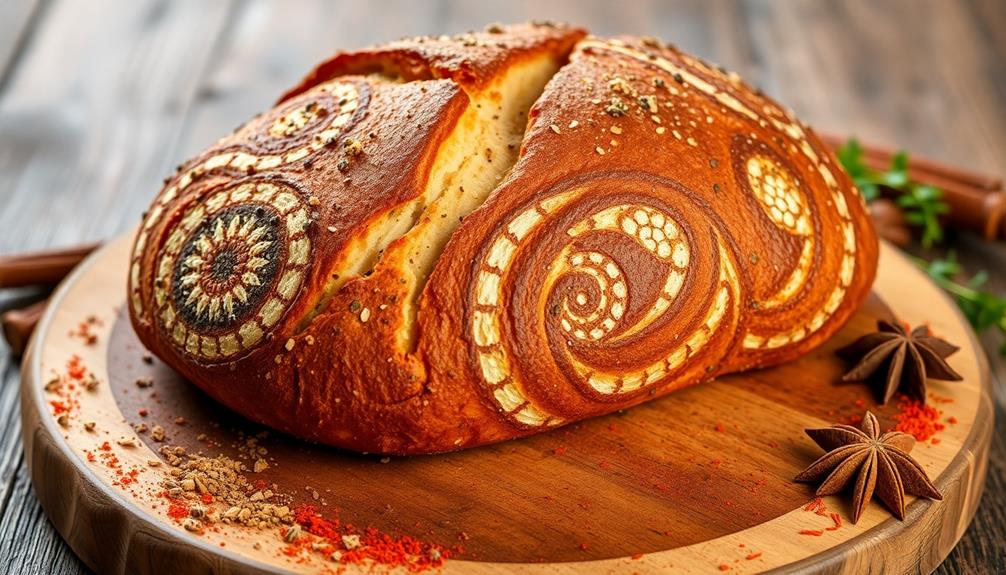Immerse yourself in the vibrant, earthy flavors of Misir Wat, Ethiopia's beloved red lentil stew. This centuries-old dish reflects the rich cultural heritage and shared mealtime experiences of the region. Sauté onions, garlic, and spices, then simmer the lentils with tomatoes until they transform into a creamy, comforting delight. Savor it traditionally with injera flatbread or other grains for a satisfying meal. Customize it with extra vegetables or adjust the spice levels to your taste. Dive deeper into the diverse flavors and traditions that make Misir Wat a beloved staple in Ethiopian cuisine.
Key Takeaways
- Misir Wat is a vibrant red lentil stew that is a staple dish in Ethiopian cuisine, reflecting its rich culinary heritage and cultural significance.
- The authentic flavor of Misir Wat is achieved through a balanced blend of spices, slow simmering, and the use of locally sourced ingredients like lentils, onions, and tomatoes.
- Traditionally served with injera (Ethiopian flatbread) or other grains, Misir Wat offers a comforting and satisfying meal experience, often featured in cultural festivals and gatherings.
- Misir Wat can be customized by experimenting with additional vegetables, adjusting spice levels, or substituting lentils with chickpeas, allowing for diverse flavor variations within the dish.
- Misir Wat is celebrated for its depth of flavor, combining earthy lentils, fragrant spices, and tangy tomatoes, making it a beloved choice in Ethiopian cuisine.
History
Originating from the rich culinary traditions of Ethiopia, Misir Wat has been a staple dish for centuries. This vibrant red lentil stew has deep roots in the country's history, reflecting the diverse flavors and cultural influences that have shaped Ethiopian cuisine over time.
Traditionally, Misir Wat was often served as part of larger feast-like meals, particularly during religious festivals and celebrations. The dish's rich, spicy aroma and comforting texture have made it a beloved comfort food for generations of Ethiopians.
Over the years, the recipe has evolved, with different regions and households putting their own unique spin on the classic dish, though the core ingredients of lentils, onions, garlic, and an array of spices remain the same.
Today, Misir Wat continues to hold a prominent place in Ethiopian culinary traditions, serving as a symbol of the country's vibrant cultural heritage and the enduring power of shared mealtime experiences.
Recipe
Misir Wat, a vibrant and flavorful red lentil stew, is a beloved dish in Ethiopian cuisine. This hearty and comforting dish isn't only delicious but also packed with nutritious ingredients, making it a fantastic choice for a satisfying meal.
The key to a truly authentic Misir Wat lies in the careful balance of spices and the slow simmering process, which allows the flavors to meld and develop. The result is a rich, aromatic stew that will tantalize your taste buds and warm your soul.
- 1 cup red lentils, rinsed
- 1 onion, diced
- 3 cloves garlic, minced
- 1 tablespoon berbere spice mix
- 1 teaspoon ground ginger
- 1 teaspoon ground cumin
- 1 teaspoon smoked paprika
- 1 can (14.5 oz) diced tomatoes
- 4 cups vegetable or chicken broth
- Salt and pepper to taste
- Chopped parsley for garnish
In a large pot, sauté the diced onion in a bit of oil or ghee until translucent. Add the minced garlic and continue cooking for another minute, stirring constantly to prevent burning.
Stir in the berbere spice mix, ground ginger, cumin, and smoked paprika, and cook for 2-3 minutes to toast the spices and release their aroma.
Next, add the rinsed red lentils, diced tomatoes, and broth. Bring the mixture to a boil, then reduce the heat to low, cover, and simmer for 30-40 minutes, stirring occasionally, until the lentils are tender and the stew has thickened. Season with salt and pepper to taste.
When serving, garnish the Misir Wat with freshly chopped parsley. This dish is traditionally served with injera, a spongy Ethiopian flatbread, but it can also be enjoyed with rice or other grains.
For an extra flavor boost, consider adding a dollop of yogurt or a squeeze of lemon juice just before serving.
Cooking Steps
First, soak the lentils in water to soften them.
Next, chop the onions, garlic, and ginger.
Then, sauté the onions, garlic, and ginger in a pan until fragrant.
Add the spices and tomatoes, and let the mixture simmer.
Step 1. Soak Lentils in Water
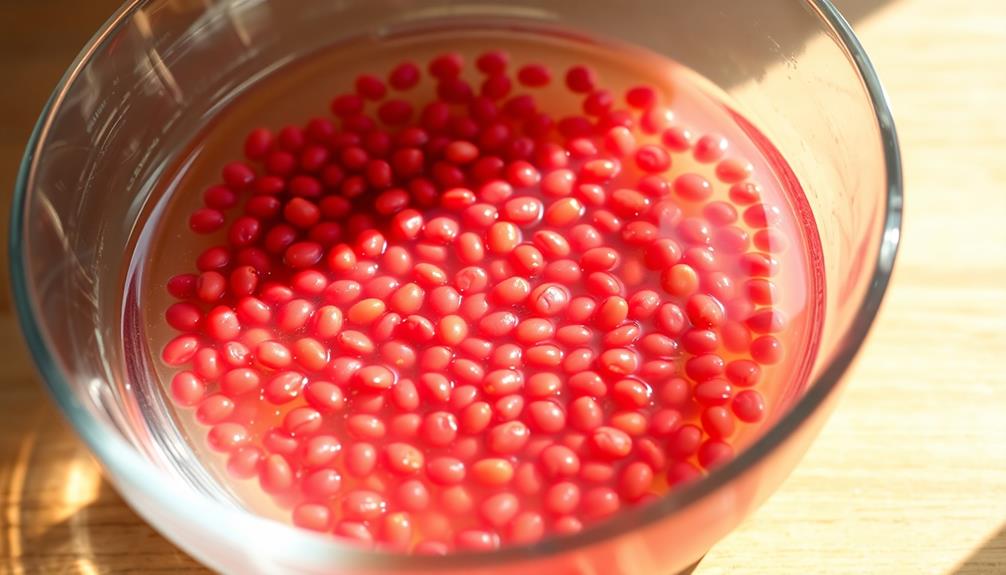
To begin, soak the lentils in water for at least 30 minutes. This crucial step helps soften the lentils and prepares them for the cooking process.
Place the lentils in a large bowl and cover them with water, making sure they're fully submerged. Let them sit undisturbed for half an hour, allowing the lentils to absorb the water and become more tender.
Once the 30 minutes are up, drain the lentils thoroughly in a colander. Gently rinse them under running water to remove any remaining impurities.
This step ensures your Misir Wat will have a clean, vibrant flavor. Now that the lentils are ready, you can move on to the next stage of the recipe – sautéing the onions and garlic.
Step 2. Chop Onions, Garlic, and Ginger
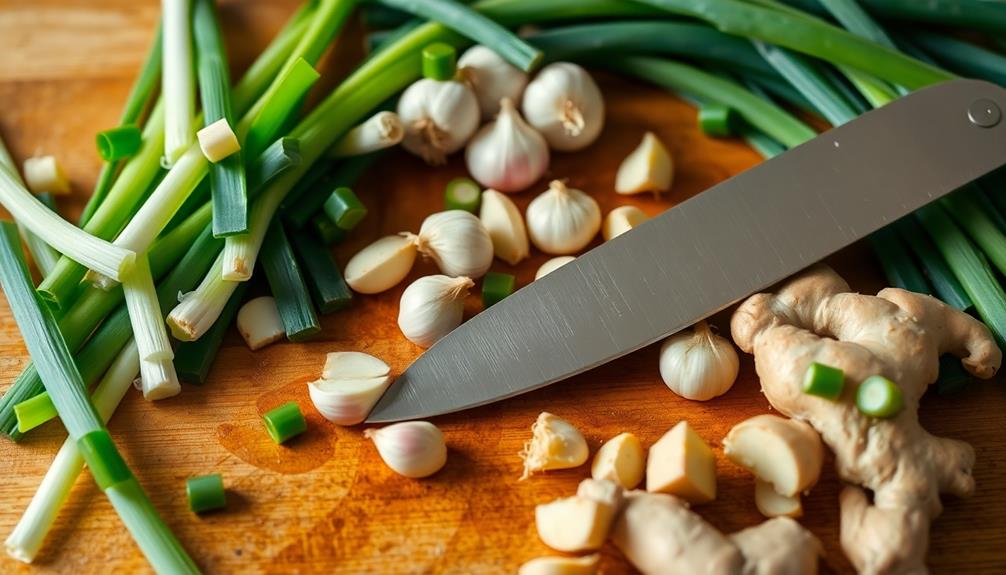
Next, finely chop the onions, garlic, and ginger. You'll want to do this step carefully, as the flavors of these aromatic ingredients will be crucial to the overall taste of the stew.
Start by peeling the onions. Slice them in half lengthwise, then thinly slice them crosswise. This will give you small, even pieces that will cook quickly and evenly.
For the garlic, peel the cloves and mince them into tiny pieces using a sharp knife or a garlic press. As for the ginger, peel the skin off with a spoon or a small knife, then grate it using a microplane or a fine grater. Aim for about 2 tablespoons each of chopped onions, garlic, and grated ginger.
Once you have all the aromatics prepped, you're ready to move on to the next step in creating your delicious Misir Wat stew. For the Misir Wat stew, you’ll need to heat up some clarified butter in a large pot and then add the aromatics to infuse the oil with their flavors. Once the onions are caramelized, you can add the berbere spice blend to the pot to give the stew its signature spicy and aromatic flavor. This Misir Wat stew is a traditional Ethiopian dish that is perfect for anyone looking to spice up their dinner with a unique and flavorful recipe. If you’re a fan of Ethiopian cuisine, then you’ll definitely want to try this spicy chicken stew recipe.
Step 3. Sauté Onions, Garlic, and Ginger
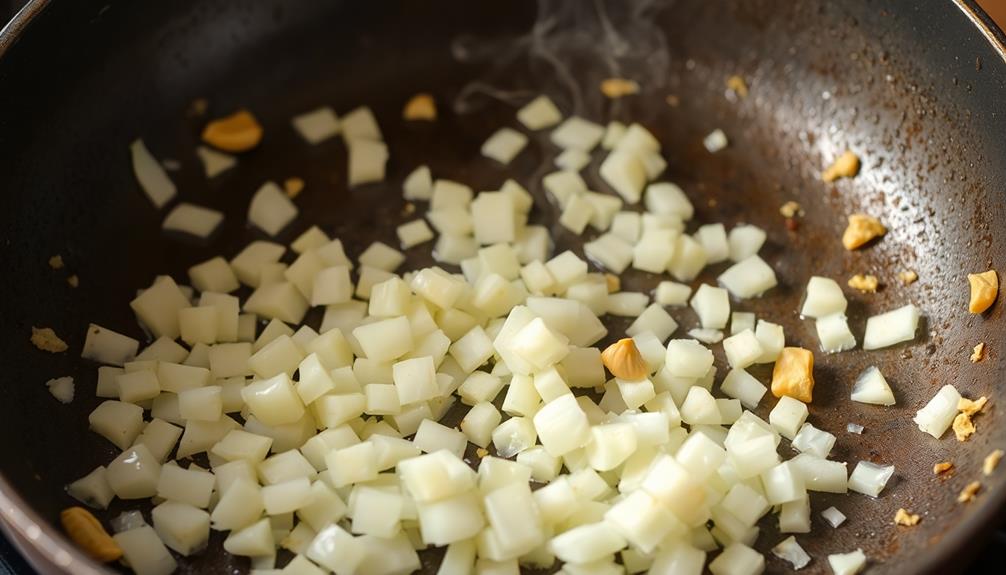
With the aromatic ingredients prepped, you can now begin sautéing the onions, garlic, and ginger. In a large pot or Dutch oven, heat a few tablespoons of oil over medium heat.
Once the oil is shimmering, add the chopped onions and sauté for 4-5 minutes, stirring occasionally, until they soften and start to turn golden.
Next, add the minced garlic and grated ginger. Continue sautéing for another 2-3 minutes, being careful not to let the garlic burn.
The fragrant aromas will fill your kitchen, signaling that the base of the stew is coming together nicely.
Sautéing the aromatics in this way helps to develop their flavors and ensures they're well-incorporated into the final dish. This step lays the foundation for the rich, complex taste of the Misir Wat.
Keep a close eye on the pot, adjusting the heat as needed, to achieve the perfect sauté.
Step 4. Add Spices and Tomatoes
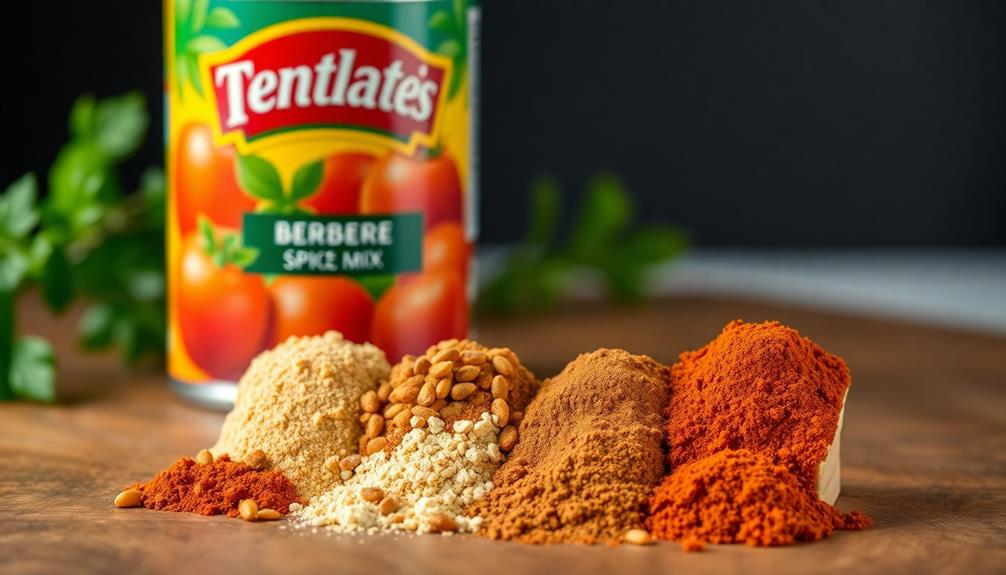
Once the onions, garlic, and ginger have been sautéed to perfection, you'll add the spices to the pot. First, sprinkle in the aromatic ground coriander, turmeric, and cumin. These spices will infuse the stew with warm, earthy flavors that complement the lentils beautifully.
Next, stir in the paprika, which lends a touch of smoky sweetness and vibrant red color to the dish. To balance the warmth of the spices, you'll then add diced tomatoes. The tomatoes will break down and create a rich, tomato-y broth that ties all the flavors together.
Be sure to give the pot a good stir, ensuring the spices are evenly distributed. Let the stew simmer for a few minutes, allowing the flavors to meld and the tomatoes to soften.
The end result will be a deeply flavorful, vibrant red lentil stew that's sure to tantalize your taste buds. If you’re looking to add even more depth of flavor to this dish, consider incorporating some sauerkraut and a variety of meats such as sausage, pork, and beef. This will give the stew a hearty and satisfying quality that is reminiscent of a traditional Polish bigos recipe. Serve the stew with some crusty bread for a complete and comforting meal that will warm you up from the inside out.
Step 5. Add Lentils and Simmer

After adding the spices and tomatoes, it's time to introduce the lentils to the pot. Grab your dried red lentils and give them a quick rinse. Then, pour them into the simmering mixture, stirring to combine. The lentils will add heartiness and texture to the stew.
Now, let the whole thing simmer for 20-25 minutes, or until the lentils are tender and have absorbed all the wonderful flavors. Stir occasionally to prevent sticking.
As the stew cooks, the lentils will break down slightly, creating a thick, creamy consistency. Keep an eye on the pot, adding a splash of water or broth if the stew starts to look too dry. You want a nice, saucy consistency that coats the back of a spoon.
Once the lentils are perfectly tender, your Misir Wat is ready to serve! Ladle the fragrant, boldly-colored stew into bowls and prepare to enjoy the delicious results of your culinary efforts.
Final Thoughts
The Misir Wat is a delightful, aromatic dish that captures the essence of Ethiopian cuisine. This vibrant red lentil stew is the perfect blend of spices, herbs, and vegetables, creating a comforting and satisfying meal.
Whether you're enjoying it on a cozy evening or sharing it with loved ones, the Misir Wat is sure to impress.
The combination of the earthy lentils, fragrant spices, and tangy tomatoes results in a depth of flavor that will have you coming back for more. Serve it alongside injera, the traditional Ethiopian flatbread, for a truly authentic experience.
Don't be afraid to experiment with your own variations, adding extra vegetables or adjusting the spice level to suit your taste buds.
The Misir Wat is a testament to the rich culinary traditions of Ethiopia. Embrace the warmth and vibrant colors of this dish, and let it transport you to the heart of this captivating country.
Frequently Asked Questions
What Is the Origin of the Name "Misir Wat"?
You're curious about the name "misir wat," aren't you? Well, it's a dish with roots in Ethiopian cuisine, where "misir" refers to the red lentils used, and "wat" means stew. So the name simply describes the main ingredients of this flavorful dish.
Can Misir Wat Be Made Vegetarian or Vegan?
Absolutely, you can make a vegetarian or vegan version of this dish. Simply omit the animal-based ingredients and use plant-based alternatives. It's a versatile recipe that lends itself well to dietary modifications.
How Long Does Misir Wat Typically Take to Prepare?
Preparing this dish typically takes around 30-40 minutes. The time required can vary depending on your cooking experience and the complexity of the recipe you're following. With some practice, you'll be able to whip it up in no time.
Can Misir Wat Be Frozen for Later Use?
Yes, you can freeze misir wat for later use. The stew freezes well and can be reheated when needed, making it a convenient option for quick and easy meals. Just be sure to store it properly in an airtight container.
What Are Some Common Accompaniments for Misir Wat?
Common accompaniments for this dish often include injera, a spongy Ethiopian flatbread, which you can use to scoop up the stew. You might also enjoy it with rice, potatoes, or a simple salad.
